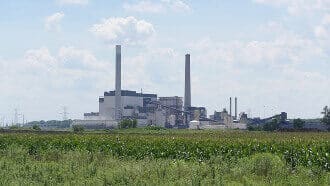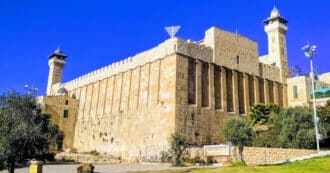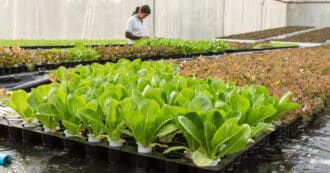By Ethel Mendius – Coal played an essential role in the industrial revolution. It is the most abundant fossil fuel and a source of heat and power generation that dates back millennia. However, burning coal causes air pollution and climate change.
Policy makers and industry specialists have turned their attention towards mitigating the environmental effects of burning coal. The U.S. government and private firms have invested billions in so-called clean coal plants using an approach called carbon capture. Most of these new coal plants, including one in Alabama that cost $7.5 billion, have stalled.
With coal production reaching an all-time high in 2022, there is a mounting demand for clean coal technologies. However, the results we have seen so far cast doubts that we can make coal clean enough to justify its use.
The History Of Clean Coal
“Clean coal” has become a catch-all phrase encompassing several different initiatives. To make sense of clean coal, we must determine what its proponents are seeking to achieve.
The environmental impact of coal burning power plants has been scrutinized for decades. In the 1980s, when acid rain was a major concern, the Department of Energy launched its Clean Coal program to prevent coal combustion from producing “acid-rain-causing chemicals such as sulfur dioxide and nitrogen oxides” using carbon scrubbers and catalytic converters.
In the 1990s, coal power plants were linked to mercury emissions, which can “become a health hazard for humans and damage ecosystems and wildlife.” At this time, mercury emissions reduction became another marker of cleaner coal.
Federal programs have often promoted a quick fix for these pollutants: make coal cleaner by refining it with chemicals. Despite billions of dollars of subsidies, research has shown that these efforts have not been effective at reducing pollution, least of all for its contribution to carbon emissions, which accelerate global warming.
Clean Coal Today
In 2009, the EPA formally recognized carbon dioxide as a pollutant. Julio Friedmann, a senior research scholar at Columbia University’s Center on Global Energy Policy, argues that “coal cannot be clean unless it controls carbon dioxide emissions as well.”
In light of the climate crisis, “clean coal” must signify coal plants that both do not contribute to air pollution (be it sulfur dioxide, nitrogen oxide, or mercury) and whose carbon emissions are neutralized or offset.
Clean Coal: Carbon Capture & Storage
Carbon capture and storage, the preeminent clean coal technology, has been promoted by government and industry alike as a solution for coal fired plants to reduce their emissions. According to the Center for Climate and Energy Solutions, “carbon capture, use, and storage technologies can capture more than 90 percent of carbon dioxide emissions from power plants and industrial facilities.”
Carbon capture requires an overhaul of existing coal plants: “current systems must be redesigned to capture and concentrate carbon dioxide” either before or after combustion, using technologies that can isolate carbon dioxide. After this process, the carbon dioxide must be stored, usually “injected into geological formations and stored deep underground.”
Carbon capture has been lauded as having “the potential to help achieve global net zero by 2050 and even to mitigate job loss in high-emission industries”, so it is an attractive solution to the environmental harms of the coal industry. However, while small-scale plants show promise, “carbon capture, utilizations and storage at scale remains largely unproven.”
Widespread implementation is challenging and often cost-prohibitive. The International Energy Agency affirmed in a report that “carbon capture and storage is advancing slowly, due to high costs and lack of political and financial commitment”, but little else besides carbon capture systems could effectively reduce our emissions.
The IEA makes reference to another technology associated with clean coal, specifically supercritical and ultra-supercritical coal fired power plants, also known as “high-efficiency low-emissions” plants. Unfortunately, these coal plants have only been shown to reduce emissions by 25%.
When proposing alternatives to carbon capture, organizations must remember the ultimate goal of clean coal is to integrate the coal industry into a framework of sustainable development and not merely to mitigate its worst harms. If industrial society wants to continue to rely on coal for power generation and for jobs, it will need to invest in the technology that makes coal plants compatible with sustainable development goals.
If these policies are not lucrative enough to draw support from investors alone, it will make sense for governments to facilitate them. However, what we have seen so far casts doubts on the advisability of funding clean coal projects altogether.
The Clean Coal Power Initiative
The U.S. Department of Energy initiated its third Clean Coal Power Initiative in 2009. Since then, they have invested almost a billion dollars into carbon capture systems, taken in part from the American Recovery and Reinvestment Act combined with private capital.
Their goal was to “make progress toward a target CO2 capture efficiency of 90 percent” through projects all around the country. This Clean Coal Power Initiative has fallen short by several measures.
In a 2021 study, the U.S. Government Accountability Office surveyed $1.1 billion of government dollars, including funds from the American Recovery and Reinvestment Act, invested in carbon capture since 2009. They found that $684 million was invested into eight coal projects but resulted in only one operating facility.
These failings were chiefly due to economic reasons “including decreased natural gas prices and uncertainty regarding carbon markets” that rendered their goals impractical. Lack of cost control within the Department of Energy resulted in an expenditure of $472 million—almost $300 million more than planned—on unfinished projects.
The Cost of Carbon Capture
The Southern Company power plant in Alabama is one example of the Clean Coal Power Initiative going awry due to setbacks that undermine its economic viability. This site was intended as “a model for coal’s future” and was funded with $2.9 billion to build the plant.
In reality, $7.5 billion was spent on the plant with production “more than three years behind schedule.” Eventually, the Southern Company executives decided to cut their losses and convert the plant to run on natural gas, another fossil fuel.
For many energy specialists, these examples are a nail in the coffin for clean coal technology, which is simply too expensive. Private investors and shareholders are now turning away from these projects. Kelley Williams, chairman of a free-market economics group, explains that “It’s hard to make any investment in cleaning up coal, when you’re looking at natural gas as an alternative.” Without the support of the private sector, it is wasteful for the government to keep spending on clean coal.
Continued support for clean coal
Despite these results, carbon capture and storage continues to receive bipartisan support in the U.S. In November 2021, Congress passed an infrastructure bill including $2.5 billion for carbon capture and storage demonstration projects and $6 billion for other large scale carbon capture projects.
This bill marks “the largest investment in carbon capture and storage in the history of the technology”. The Department of Energy defends their projects on the basis that “globally many new coal power plants will continue to be built in coming decades” and therefore carbon capture and storage is “an essential mitigation option.”
Environmental advocates such as Adrien Salazar, policy director at the nonprofit Grassroots Global Justice Alliance, see these federal investments as greenwashing: “they are simply fossil fuel subsidies by another name.” He argues that we should stop deploying billions of dollars “to prop up the industries responsible for the climate crisis through fantasy technologies” such as carbon capture and storage.
Ironically, in one respect Salazar’s position aligns with those in the energy industry, such as the Southern Company shareholders; both see clean coal as a poor investment.
Clean Energy
At the very least, these attempts demonstrate that clean coal is an unwise use of taxpayer dollars. In the bigger picture, the transition away from coal, clean or otherwise, is part of the broader process of “decarbonization, or making our world less centered around carbon emitting technology,” a necessary step for the conservation of our planet.
Decarbonization requires an overhaul of reliance on fossil energy in favor of clean, renewable alternatives. Solar and wind power are economically sustainable and the fast-growing sources of clean energy.
These “cleaner, more efficient” energy sources are cheap to construct and maintain, and would be even cheaper with greater government support and fewer subsidies for fossil energy, which pose a massive barrier to decarbonization. A 2020 report by the The International Renewable Energy Agency found that of $634 billion in energy sector subsidies in 2020, 70% went to fossil fuels, and only 20% went to renewables.
The rationale behind government subsidies are “often intertwined with its industrial policies.” If we could reconcile the priorities of our government with the necessities of the planet, clean energy would be easier to achieve.
Lifestyle Changes
The overhaul of our current energy system is no small task. An IEA report on the global net zero goal acknowledges that “a transition of such scale and speed cannot be achieved without sustained support and participation from citizens, whose lives will be affected in multiple ways.”
Today’s societies are addicted to fossil fuels, and this is not only the industrial sector and its employees. Anytime we fill up our gas tanks or even come into contact with disposable plastics, we are demonstrating our direct and personal relationship with fossil energy.
As we rethink our energy sources, it is also worth pondering how our species developed a reliance on energy source that could in our lifetimes lead to the global temperature rising 1.5 °C (or 2.7 °F) from pre-industrial times. Our individual reflections will not directly influence this figure, but they may help as we align ourselves with policies to combat it.
Clean Coal And Religion
In light of the major impacts of burning coal like air pollution and climate change, many religious leaders recognize the importance of keeping coal in the ground and transitioning away from burning coal.
An article for Politico discusses how Pope Francis’ encyclical “Laudato Si” is creating tension for religious Catholics who also highly value using coal for fuel. Pope Francis comes out strongly against coal in Laudato Si, describing how “technology based on the use of highly polluting fossil fuels – especially coal, but also oil and, to a lesser degree, gas – needs to be progressively replaced without delay.”
The Politico article details how Pope Francis’ Laudato Si was viewed by Poles as “an ‘anti-Polish’ encyclical” according to Poland’s Rzeczpospolita newspaper. This is no surprise, as Poland’s coal industry “employs about 100,000 people and generates almost 90 percent of its electricity.”
As we move into a more sustainable future, we need to recognize the extent to which sustainability itself is perceived as a highly political issue, with many people afraid of losing their jobs or afraid of their country being harmed because of their economic dependence on fossil fuels.
But if we stop fighting against coal because of short term concerns, the long term consequences can be catastrophic. According to Thea Ormerod, the chair of the Australian Religious Response to Climate Change (ARRCC):
Our conviction has been growing that the greatest damage Australia is doing to global climate systems is through our coal and gas exports.
That Australia continues with expansionary plans amounts to willful neglect of our collective moral responsibility. Thus, our resistance must continue. What is at stake is, firstly, the life chances of those in developing countries at the front line of climate impacts and secondly, humanity’s long-term survival. Other species with which we share this planet are also under threat.
Can we ensure good jobs and a flourishing planet Earth? At ICSD, we say yes. May God help us to work together to find sustainable solutions that help us flourish in both the short term and for many generations to come.
* Featured image source








